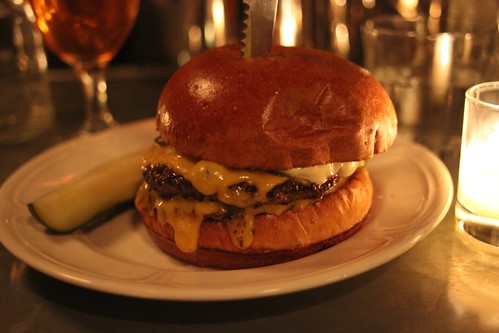
Here’s the first thing that happened at Au Cheval, the Randolph Street “diner,” that has never happened to me at any diner ever before. I sat at the bar, ordered a beer, and then asked for a menu. At which point I caused some consternation and hemming and hawing, which finally ended with the waitress saying “It’s late enough, I guess you can.” I’m not sure exactly what that meant, but surely part of what makes you a diner is that there’s a counter— not a bar, a counter— and no one has ever, ever, had to think about whether you could have food there or not. (I’m also pretty sure no counter has a thick brass pipe holding the beer taps set exactly at eye level, so that talking to your bartender is like talking to your lawyer in stir.)
When the concept of Au Cheval was announced I made some cracks on Twitter about what kind of a “diner” had a French name and foie gras in its matzoh balls and could be described, as Eater described it, as having
a vintage French bordello vibe with large hanging pendants over a zinc-topped bar, exposed whitewashed brick and black venting, an antique mirror hanging on the front wall, maple-stained driftwood tabletops alongside slightly distressed leather booths, basket weave marble tile and wallpaper with patterns resembling the ubiquitous fleur de lis at Sodikoff’s neighboring Maude’s Liquor Bar.
As I said at Grub Street, I’m pretty sure all that doesn’t come with a side of hash browns and a secondhand Sun-Times, like things do at a real diner. Eventually I went off on this enough that I got a tweet back from Brendan Sodikoff saying, basically, that diner-ness was a state of mind, an air of welcoming that they were aiming for. Okay, fair enough, I thought; maybe even as the design trappings and the menu suggest French decadence, there’s a core of Norman Rockwell small town cafe attitude underneath it all. I could buy that.
Unnh-unnnnh, I’m not buyin’ it any more. Not since I finally went there. As far as I’m concerned, Sodikoff is calling Au Cheval a diner because he doesn’t want to use the perfectly good American phrase that describes exactly what Au Cheval is: a singles bar. I haven’t been in such a blatant pickup scene since I watched the spry 70-year-olds hit on each other at Myron and Phil’s on a Friday night. (Yeah, I’m talking to you, guy getting all touchy with the waitress as he mentions his wife repeatedly to the guy he’s drinking with.) But it’s a singles bar with— not even just comfort food. Frankly, Au Cheval’s food is so big and heavy that it’s more like discomfort food; touchy married guy had a basket of Texas toast to go with the chicken liver, each slice of which was big enough to wreck your Atkins for a month. I’ve seen diners serve Adam and Eve on a raft, but never lifesize before. But what’s going on in America that people are coming together to mate with a fig leaf of deniability provided by overloaded fat guy food? Why do the skinny people need each other to think that they’re eating like LTHers before they’ll screw?
Everyone tells me that Sodikoff is a brilliant guy, so maybe he understands something about our weird psychology about food that I can’t see; the fact that he’s basically 4 for 4 so far in terms of opening places that get lines out the door would certainly suggest that possibility. But then there’s the food. Many of the same people told me that, as absurd as it often sounds, the food at Au Cheval was jaw-droppingly delicious. They weren’t always entirely complimentary about it— David Tamarkin succinctly said what I had sort of suspected, which was: “You can eat here, and you can eat well. You just can’t eat dinner,” that is, you can eat fatty rich things that will leave you sated and half insensate, but they don’t constitute a balanced, personally sustainable approach to dinner as the term is understood by adults. But others raved; Ellen Malloy (who has no professional relationship with Sodikoff) said she was blown away by her meal, and Michael Nagrant said, “if you like food, like really like food (and this is an important distinction), there are few better places in Chicago.”
Yeah, I’m not buyin’ that either. I figured for a base opinion, I might as well start with the hamburger, which Nagrant called “thin gridlded, juicy pre-World War II-era burgers (rivaled locally only by maybe Schoops in Hammond or Edzo’s in Evanston),” and which Mike Sula called “among the most unique and well played in recent memory.” I grant you that the burger manages to achieve a degree of the stewed-in-its-own-juices flavor that marks many great diner burgers, but which is nearly always lacking in bar burgers. Okay, so that means basically they do as good a burger as Top Notch Beefburger in Beverly, and I don’t even mind that theirs is three times as much— $9 is high but not crazy for a burger, $5 is higher but still not unprecedented for some excellent Belgian-style frites (served, of course, in a Belgian-style cone— like all diners do).
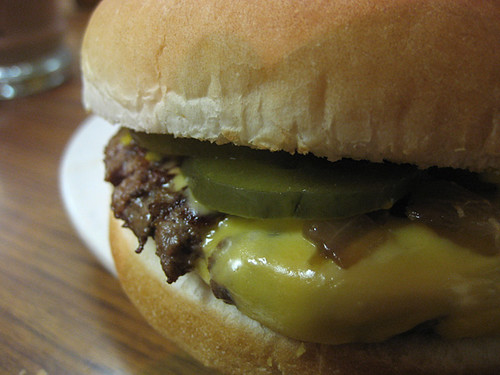
Top-Notch Beefburger.
Except it’s not as good as a Top-Notch Beefburger, at least not for very long. Maybe with simple ketchup and mustard and pickles and grilled onions it would be. But the burger comes with— God, I don’t even know what all that stuff was. There was a kind of white horseradish-tasting sauce that was something like bechamel, and there was lots of gooey cheddar leaking from the middle, and my fries came with a little cup of mayo; if I had ordered something else I felt like it would have been sure to come with a side of spackle or tub & tile caulk. After it was all delivered the waitress asked me if I wanted ketchup and mustard, and besides my doubts about this burger’s ability to hold any more fluids, it was asked in a way that was almost designed to make me feel ashamed for asking, as she might have asked touchy married guy if he’d be needing some condoms this evening. So I ate this burger of white gooey fluids as much as I could, but the moment came when all this whiteness solidified into Elmer’s Glue and I could not, under any circumstances, put another bite of that hamburger in my mouth. In fact, at the moment I have trouble imagining that I can eat Au Cheval’s food ever again, even setting aside the atmosphere (which, with its air of ruthlessly Darwinian sexual selection, was the very antithesis of small town diner-welcoming to me). I read those other reviews and I think I might like someday to try duck heart in gravy-smothered hash (“by far my favorite dish” —Nagrant)… and then I think of that burger setting like cement, and I’ll never be hungry again.
* * *
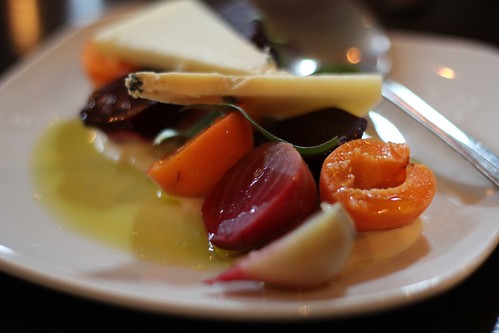
Although they’re barely two blocks apart, no one would normally think of Vera and Au Cheval together. Their vibe is as different as could be. But Vera does have a concept, too— it’s a Spanish restaurant, albeit the least deliberately evocative of tourist Spain imaginable; the room is just contemporary American restaurant, the soundtrack is whatever fairly modern thing is on chef Mark Mendez’s iPod, no flamenco music or bullfighting poster has ever stepped across its threshold. The Spanish-ness is all in the culinary approach, which is simple and direct. Which is why, at moments at Au Cheval, I found myself thinking about a meal a week earlier at Vera— it gave my fevered brain respite from the moment-by-moment calculation of what my experience was supposed to be at Au Cheval, who I was supposed to be eating that food while the ostentatiously displayed tape player slowly revolved and the scene played out.
Likewise, I never had to think about the food, about what it was seeking to be, what archetype it was trying to evoke and update in what way at Vera. There were fresh anchovies. They were dressed with olive oil and some citrus. They were maybe the best thing I’ve eaten all year (this was the second time I’ve had them). Not because they evoke some cultural archetype of a Jungian memory of a Catalan fish dock shack, but because they were fresh anchovies, dressed with olive oil and some citrus, which fill your mouth with a bright white citrusy light. Not since the crispy en choy at TAC Quick with all its fish sauciness have I felt like a single dish opened new horizons every time I ate it.
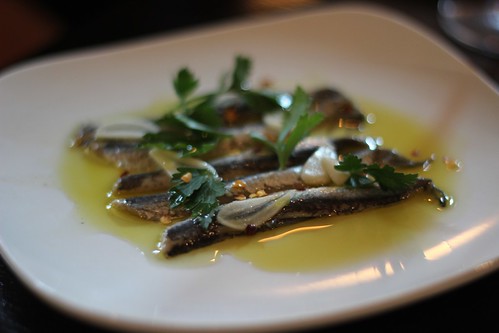
I’ve eaten, I think, four times at Vera by now. A few things have been unexciting— I’m not wild about the way he roasts root vegetables in winter; one meal was kind of half-wasted when I ordered what turned out to be two large almost identical plates of beans with pork in a tomatoey sauce, which is the sort of mistake a server should guard against on your behalf. (One of them was the tripe stew with fava beans, much loved by others, but the lesser of two to me.) But as with Mado, the prices are low enough most of the time that you can write such things off and wait for the moments when fresh things from the market are dressed or prepared so perfectly that it inspires you to eat vegetables all over again, makes meat seem a mean substitute. (This in a place where jamon iberico is a star attraction, no less.) Ezra Pound said something like, why do poets say things are like things, why don’t we just say they are? (Google fails me on the exact quote.) Dishes at Vera evoke nothing, they are the thing.
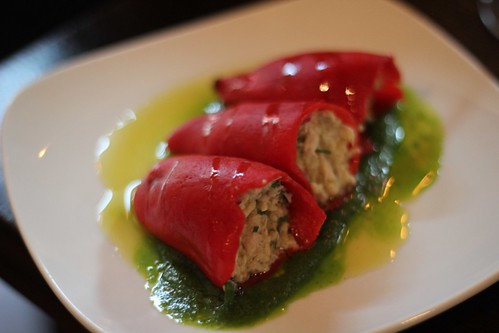


 Posted in
Posted in 




